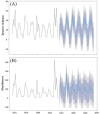Trends in the homogenization of macromoth assemblages (2016-2023) in a Seoul City park
- PMID: 41053338
- PMCID: PMC12501232
- DOI: 10.1038/s41598-025-18373-4
Trends in the homogenization of macromoth assemblages (2016-2023) in a Seoul City park
Abstract
As a Long-Term Ecological Network project in Korea, we conducted monthly macromoth sampling from May to October, 2016-2023, in Namsan Park, Seoul, at three permanent plots representing dominant tree communities: Quercus mongolica, Robinia pseudoacacia, and Pinus densiflora forests. Over eight years, we recorded 3,486 individuals from 283 species in 11 families. In total, 351 macromoth species from 13 families were documented in the city park, including 212 newly discovered species and 68 previously recorded species now disappearing. Species richness and abundance varied among the three forest types, with the Q. mongolica forest showing the highest values in both species and individuals. Overall species richness showed a nonsignificant decline, and auto regressive integrated moving average models predicted ongoing fluctuations in richness and a rising trend in abundance in the coming years. Macromoth assemblages in Namsan exhibited distinct clustering by forest type, with consistent distribution of body size groups emphasized throughout the study. Furthermore, relatively high faunal turnover within forests, combined with minimal annual variation, suggests a trend toward homogenization of macromoth assemblages across forest types. This pattern appears to be influenced by the city park's isolation, which may limit species dispersal and contribute to localized faunal differentiation.
Keywords: Diversity; Faunal change; Herbivores; Homogenization; Urban forest.
© 2025. The Author(s).
Conflict of interest statement
Declarations. Competing interests: The authors declare no competing interests.
Figures







References
-
- Seto, K. C., Sánchez-Rodríguez, R. & Fragkias, M. The new geography of contemporary urbanization and the environment. Ann. Rev. Environ. Resour.35 (1), 167–194 (2010).
-
- Ryu, J. et al. Analysis of changes in forest according to urban expansion pattern and morphological features - Focused on Seoul and Daegu. Korean Journ Rem. Sens.33, 835–854 (2017).
-
- McDonald, R. I., Kareiva, P. & Forman, R. T. The implications of current and future urbanization for global protected areas and biodiversity conservation. Biol. Conserv.141 (6), 1695–1703 (2008).
-
- Fattorini, S. Insect extinction by urbanization: a long term study in Rome. Biol. Conserv.144, 370–375 (2011).
-
- Fenoglio, M. S., Salvo, A., Videla, M. & Valladares, G. R. Plant patch structure modifies parasitoid assemblage richness of a specialist herbivore. Ecol. Entomol.35, 594–601 (2010).
MeSH terms
Grants and funding
LinkOut - more resources
Full Text Sources
Research Materials

